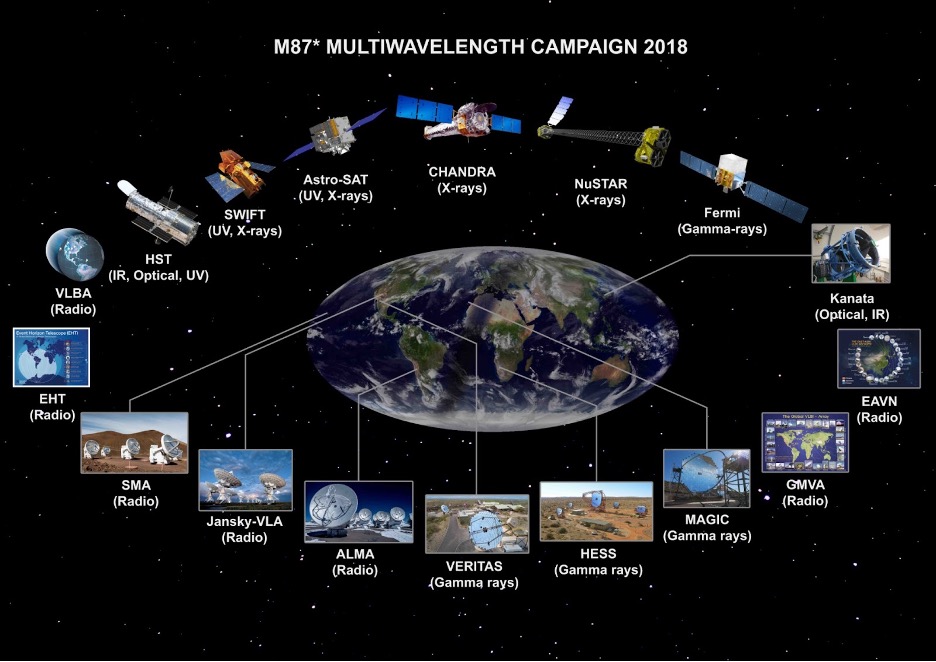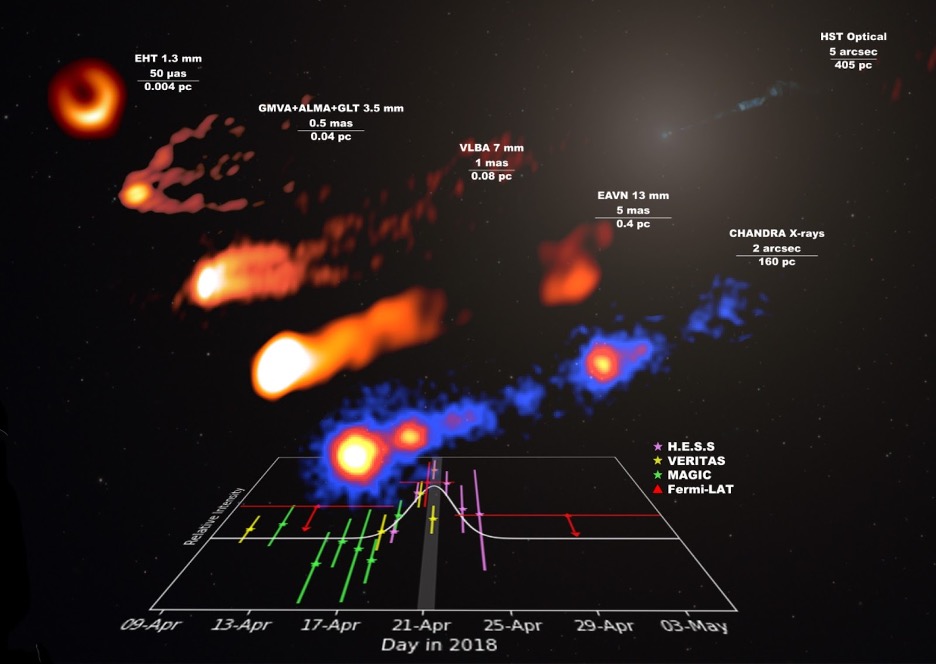The Event Horizon Telescope Collaboration Reports a Spectacular Flare from the Centre of the Messier 87 Galaxy
By Lyuba Encheva (with files from EHT press office)
Canadian Institute for Theoretical Astrophysics researchers Bart Ripperda, Ue-Li Pen and Gibwa Musoke, who are part of the Event Horizon Telescope (EHT) collaboration, are among the authors of a paper outlining the results of a multi-wavelength observational campaign conducted in April 2018.

The observatories and telescopes that participated in the 2018 multiband campaign to detect the high-energy gamma-ray flare from the M87* black hole. Credits: EHT Collaboration, Fermi-LAT Collaboration, H.E.S.S. Collaboration, MAGIC Collaboration, VERITAS Collaboration, EAVN Collaboration
The authors report the first observation since 2010 of a high-energy gamma-ray flare (detecting photons up to thousands of billions of times the energy of visible light) from the supermassive black hole (M87*) in the Messier 87 Galaxy. The study presents data from over 25 ground-based and space-based telescopes such as NASA’s Fermi, HST, NuSTAR, Chandra, and Swift, along with three of the largest Cherenkov telescopes: H.E.S.S., MAGIC, and VERITAS. The findings of this campaign have just been published in Astronomy & Astrophysics.
“The detection of a flare in multiple wavelengths gives a wealth of information about the origin of the emission. We can use that information to model radiation processes due to extreme particle acceleration near the event horizon of the black hole. Our group at CITA is doing first-principles simulations of particle acceleration events near the black hole that can potentially explain the bright and rapid high-energy emission that has been observed,” explained CITA faculty Bart Ripperda. Along with Professor Ripperda, the University of Toronto based team includes CITA Professor Ue-Li Pen, CITA postdoctoral fellow Gibwa Musoke, and Professor Aviad Levis from the David A. Dunlap Department of Astronomy and Astrophysics and the Department of Computer Science. Professor Daryl Haggard from McGill University’s Space Institute has been leading the work on the Canadian side of the EHT collaboration.
Messier 87, also known as Virgo A or NGC 4486, is the brightest object in the Virgo cluster of galaxies, the largest gravitationally bound type of structure in the universe. The powerful relativistic jet examined by the researchers is surprising in its extent, reaching sizes that exceed the black hole’s event horizon by tens of millions of times (7 orders of magnitude) – akin to the difference between the size of a bacterium and the largest known blue whale. The energetic flare, detected at multiple wavelengths, emanating from the very centre of the same galaxy, lasted approximately three days and suggests an emission region of less than three light-days in size (~170 AU, where 1 Astronomical Unit is the distance from the Sun to Earth). Its bright burst of high-energy emission was well above the energies typically detected by radio telescopes from the black hole region.
“Observing the flare with such a large number of telescopes is astounding! Investigating this high energy burst of light across numerous wavelengths provides us with unique insights into the physical processes at play close to a black hole. This brings us a step closer to understanding how these mysterious objects evolve,” shared CITA postdoctoral fellow Dr. Gibwa Musoke, who works on general relativistic magneto-hydrodynamic simulations of accreting black holes and relativistic jet launching.

Light curve of the gamma-ray flare (bottom) and collection of quasi-simulated images of the M87 jet (top) at various scales obtained in radio and X-ray during the 2018 campaign. The instrument, the wavelength observation range and scale are shown at the top left of each image. Credits: EHT Collaboration, Fermi-LAT Collaboration, H.E.S.S. Collaboration, MAGIC Collaboration, VERITAS Collaboration, EAVN Collaboration.
Related journal article: “Broadband Multi-wavelength Properties of M87 during the 2018 EHT Campaign including a Very High Energy Flaring Episode”, by The Event Horizon Telescope- Multi-wavelength science working group, The Event Horizon Telescope Collaboration, The Fermi Large Area Telescope Collaboration, H.E.S.S. Collaboration, MAGIC Collaboration, VERITAS Collaboration, and EAVN Collaboration. In: Astronomy & Astrophysics: https://doi.org/10.1051/0004-6361/202450497
Read more: McGill Newsroom, UCLA Newsroom, EurekAlert/ AAAS, CFCA Japan